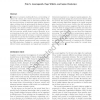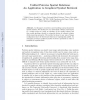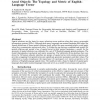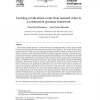108
click to vote
JOCN
2010
14 years 7 months ago
2010
Studies in semantics traditionally focus on knowledge of objects. By contrast, less is known about how objects relate to each other. In an fMRI study, we tested the hypothesis tha...
111
Voted
IJON
2010
14 years 9 months ago
2010
The visual system plays a predominant role in the human perception. Although all components of the eye are important to perceive visual information, the retina is a fundamental pa...
129
click to vote
ECAI
2010
Springer
14 years 9 months ago
2010
Springer
Bipolarity is an important feature of spatial information, involved in the expression of preferences and constraints about spatial positioning or in pairs of opposite spatial relat...
124
click to vote
IGARSS
2009
14 years 10 months ago
2009
High resolution remote sensing (HR RS) images allow discriminating between different objects in a scene. Spatial reasoning techniques can be used to interpret and describe the sce...
110
click to vote
GREC
2009
Springer
14 years 10 months ago
2009
Springer
In this paper, we present a novel unifying concept of pairwise spatial relations. We develop two way directional relations with respect to a unique point set, based on topology of ...
126
click to vote
CIARP
2009
Springer
14 years 10 months ago
2009
Springer
Abstract. Region-based approaches have been proposed to computerassisted colorization problem, typically using shape similarity and topology relations between regions. Given a colo...
132
click to vote
SOCO
1998
Springer
15 years 22 hour ago
1998
Springer
The development of formal models of spatial relations is a topic of great importance in spatial reasoning, geographic information systems (GIS) and computer vision, and has gained ...
108
click to vote
GIS
1998
ACM
15 years 1 days ago
1998
ACM
Spatial relations are the basis for many selections users perform when they query geographic information systems (GISs). Although such query languages use natural-language-like te...
120
click to vote
TVCG
2008
15 years 8 days ago
2008
Volume exploration is an important issue in scientific visualization. Research on volume exploration has been focused on revealing hidden structures in volumetric data. While the i...
101
Voted
AI
2005
Springer
15 years 8 days ago
2005
Springer
The current research presents a system that learns to understand object names, spatial relation terms and event descriptions from observing narrated action sequences. The system e...




